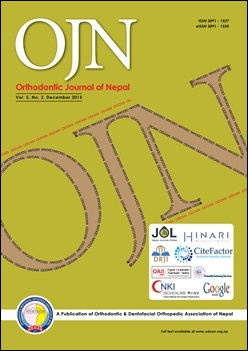Dental Aesthetic Index among Nepalese Orthodontic Patients
DOI:
https://doi.org/10.3126/ojn.v5i2.15217Keywords:
Dental Aesthetic Index, orthodontics, treatment needAbstract
Introduction: Orthodontic indices are used for the assessment of malocclusion, its severity level, and treatment need. Dental Aesthetic Index (DAI) is a simple, valid and reliable index commonly used for epidemiological survey and initial screening of the orthodontic patients.
Objective: To evaluate the frequency and severity of malocclusion and orthodontic treatment need among Nepalese patients using DAI and to compare the treatment need between gender groups.
Materials & Method: 150 pairs of maxillary and mandibular pre-treatment orthodontic study models of 59 male and 91 female patients with permanent dentition were randomly selected from the Department of Orthodontics, Kantipur Dental College. Ten occlusal traits of DAI were assessed on each pair of study models using graduated periodontal probe and metallic scale by a single examiner. Cumulative DAI scores were calculated according to standard DAI method to differentiate the severity of malocclusion and orthodontic treatment need.
Result: About 60% of the sample presented severe or very severe (handicapping) malocclusions indicating highly desirable or mandatory treatment need. 21.3% had definite malocclusion that required elective treatment need, 19.3% had normal occlusion with no or slight treatment need. There was no statistically different mean DAI scores between male and female samples (p=0.116)
Conclusion: Most of the samples were in great need of orthodontic treatment with very severe malocclusions. Male samples had greater percentage of ‘very severe’ malocclusion than female. Malocclusion was characterized with high frequency of anterior incisal irregularity, maxillary overjet, midline diastema. DAI can be used as a screening tool rather than the decision making tool.
Downloads
Downloads
Published
How to Cite
Issue
Section
License
Copyright © held by Orthodontic & Dentofacial Orthopedic Association of Nepal
- Copyright on any research article is transferred in full to the Orthodontic & Dentofacial Orthopedic Association of Nepal upon publication in the journal. The copyright transfer includes the right to reproduce and distribute the article in any form of reproduction (printing, electronic media or any other form).
- Articles in the Orthodontic Journal of Nepal are Open Access articles published under the Creative Commons CC BY License (https://creativecommons.org/licenses/by/4.0/)
- This license permits use, distribution and reproduction in any medium, provided the original work is properly cited.




